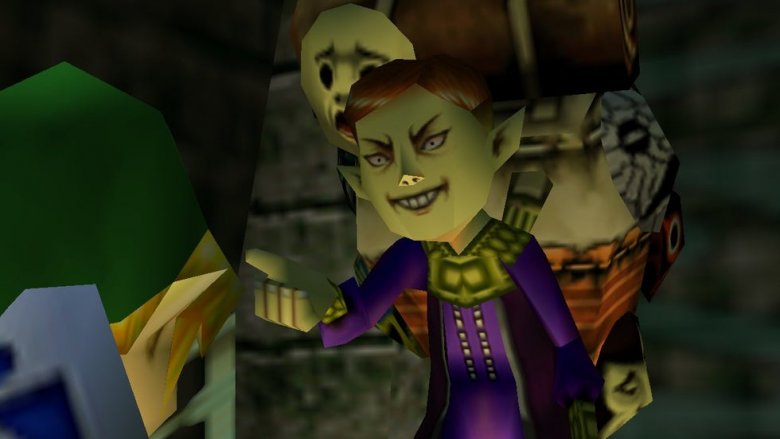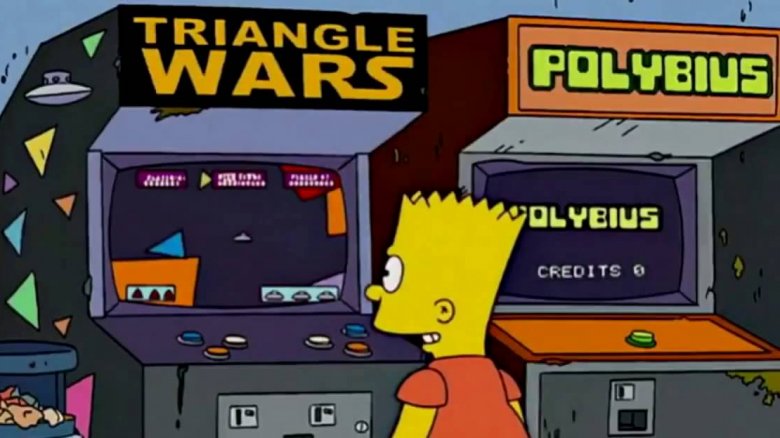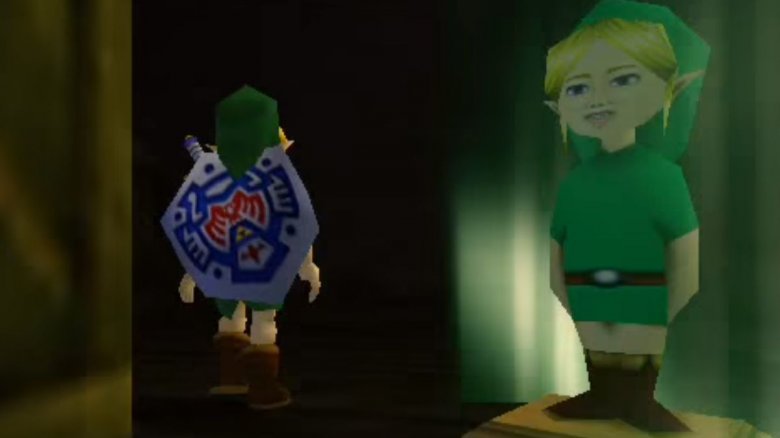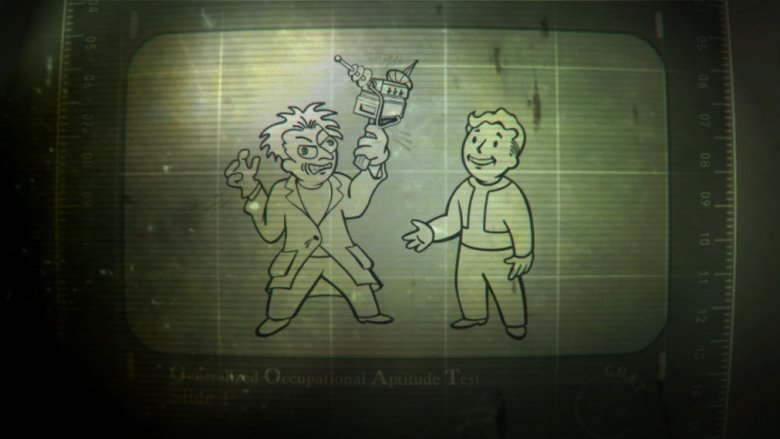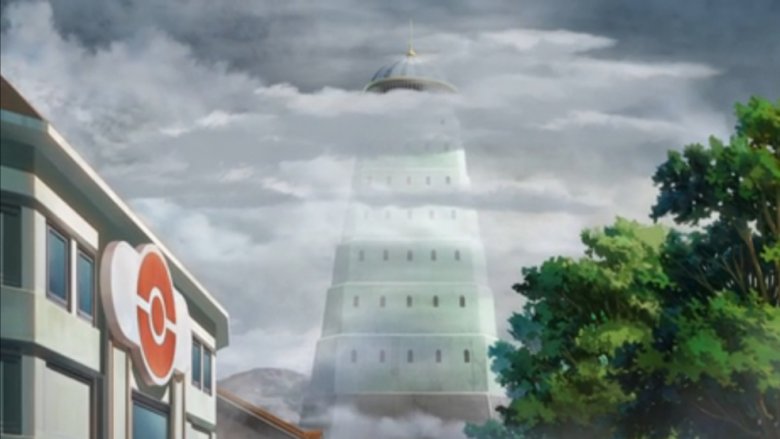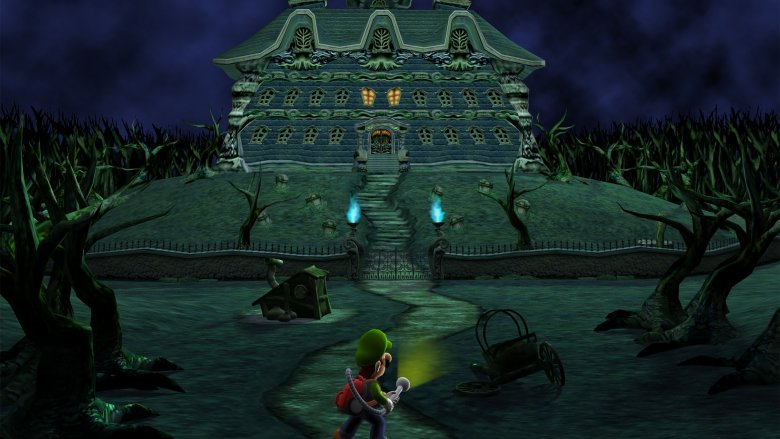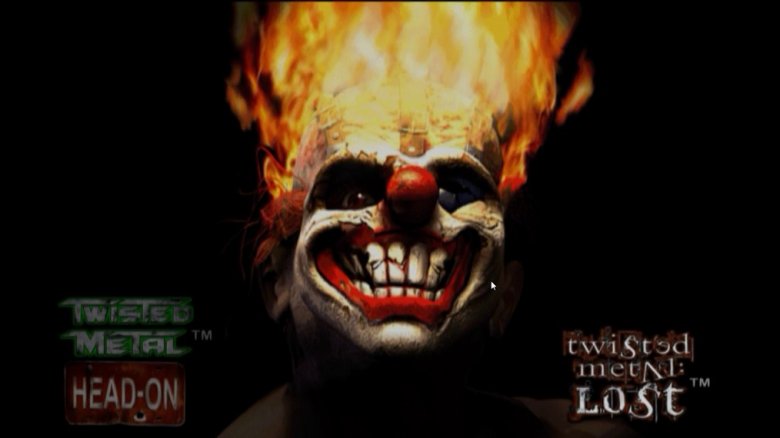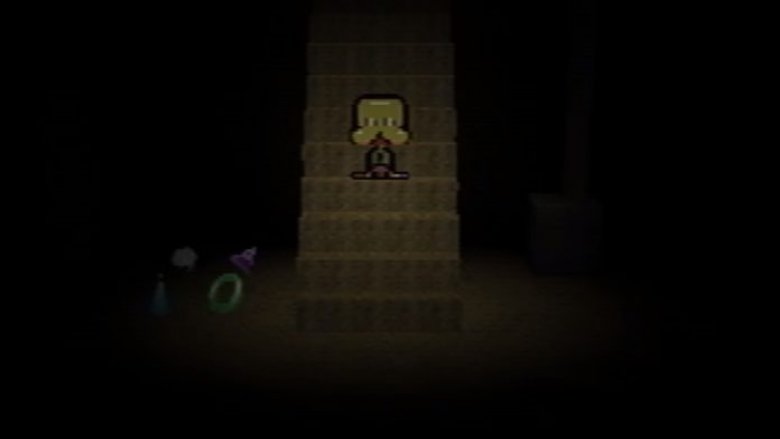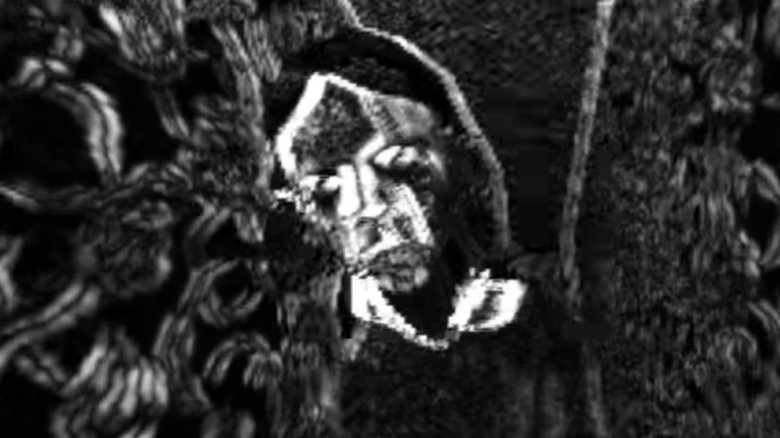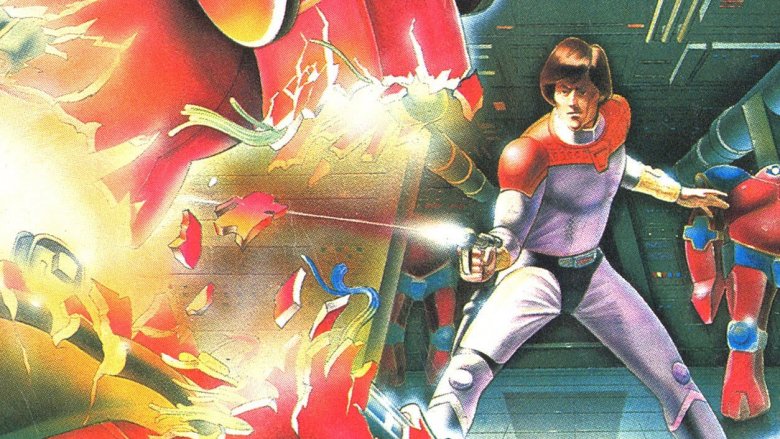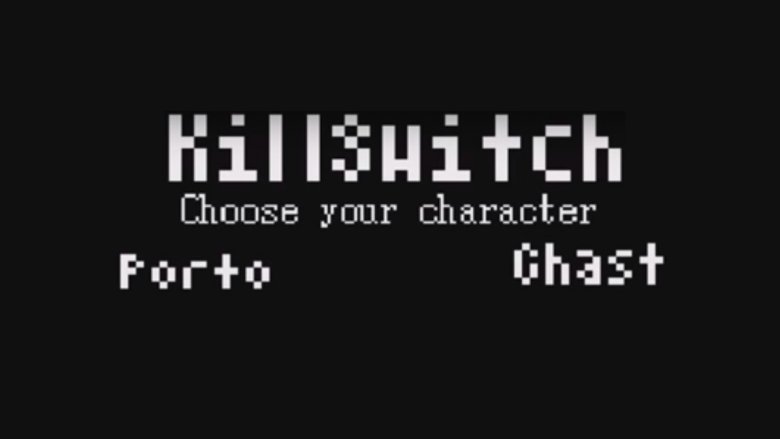Creepy Video Game Urban Legends That'll Give You Nightmares
Everyone loves a good urban legend: the man with the hook hand stalking Lover's Lane, saying "Bloody Mary" in the mirror, the gargantuan alligators infesting the city sewers. These are stories that are passed around like an eerie game of telephone, too absurd to be entirely real, but containing just enough nuggets of truth to feel disturbingly plausible.
Well, did you know that there are also urban legends involving video games? Some of these have been around for years, while many have only come about since the creation of the internet, spreading as chain letters or, like the legend of Slender Man, as a form of copy/paste horror story known as a "creepypasta." Basically, no matter the medium, urban legends have a way of snaking their way into being.
From haunted game cartridges to twisted government experiments to cursed athletes, here are some of the creepiest urban legends of the video game world. Be sure to leave a light on while you read.
Polybius, the government experiment
This may be the grandaddy of all video game urban legends: Polybius. As the story goes, this arcade game was released to the public in small numbers as part of an experiment carried out by the United States government. Stories of Polybius' effects differ depending on who is telling the tale, but players supposedly suffered from seizures and violent episodes, with some even attempting suicide after being exposed to the cabinet. In perhaps the most X-Files-sounding aspect of the legend, arcades that contained Polybius cabinets were watched closely by mysterious men in black, who would occasionally come in to keep an eye on the kids playing. These men would take notes and abscond with the cabinets when they were done (which "explains" why no one has any record of these cabinets existing in the wild).
Though Polybius has never been proven to actually exist, its legend has persisted into being almost as real in the classic arcade scene as Joust or Galaga. Over the years, Polybius has seeped its way into the subconscious of pop culture, appearing as a sight gag in The Simpsons and inspiring a music video by Nine Inch Nails.
The Madden Curse destroys MVPs
The so-called "Madden Curse" is upsetting in that it adds dread to an event that should be worth celebrating. It's also one that has gained a heightened level of notoriety over many of the more obscure entries on this list, as it has seemingly affected several high profile football players.
Essentially, this curse affects any player (un)lucky enough to be featured on the cover of one of Electronic Arts' Madden games. The curse seemed to begin in the very first year that the series featured a star athlete on the cover (previous entries featured John Madden on the box art), when running back and Madden cover athlete Garrison Hearst suffered a leg break that led to a degenerative bone disease.
Over the years, horrible injuries and career setbacks have followed athletes who have appeared on the cover of a Madden installment. Sure, there are plenty of players who have seemingly remained unaffected by the curse, but isn't that always the way with urban legends? It's way easier to get spooked out by the sheer number of misfortunes that have followed that coveted (and feared) spot in video game stardom.
The urban legend of the PlayStations of Mass Destruction
In the early 2000s, it was reported that Saddam Hussein and the Iraq military had purchased somewhere around 4,000 PlayStation 2 systems and were planning to use all of their parts to build a military supercomputer. This report was picked up by various outlets and caused a bit of a stir, despite the fact that there was no evidence that the PS2s in question were ever shipped to Iraq. Not only this but, as pointed out at the time by Wired, "If Saddam really were to build a supercomputer on the sly, he'd probably rely on hardware he already owns," rather than go through all of the trouble of converting thousands of PS2s into something that could theoretically work.
Eurogamer similarly clowned on the anonymous source that originally broke the news, saying that it all sounded "suspiciously like a Sony marketing ploy rather than the words of even the most unintelligent of military intelligence experts." Considering most of the "report" was concerned with the PlayStation 2's incredible ability to process polygons (imagine the world being brought to its knees with polygons), it sure read more like an overly excited owner's manual for the PS2 than a genuine warning of doom.
BEN drowned: A haunted Zelda game leads to a terrible fate
Playing The Legend of Zelda: Majora's Mask is already an unsettling experience. However, if one unlucky player is to be believed, the game is just a gateway to an entirely new world of terror. In the story of "BEN Drowned," a player found a seemingly haunted Majora's Mask cartridge at a garage sale. While playing, he experienced weird changes to music and dialogue in the game, but wrote this off as a glitch. The experiences became more harrowing as he began interacting with an entity calling itself "Ben" that possessed the game, which eventually affected his dreams and threatened him in the real world. Readers ate up every detail of this supposed game, trying to decipher its meaning through various message boards and posts.
The waters were muddied a bit further when the original poster uploaded videos of his playthrough, with eerie events mirroring his story. The videos were most likely made by manipulating the original game's code, but that didn't stop them from lending a kind of tangible legitimacy to this particular tall tale. As with all urban legends, it doesn't take too much convincing to buy into it.
Fallout 3 predicted the future
In Bethesda's Fallout 3, players are introduced to the character of Three Dog, who hosts the Galaxy News Radio program. Though Three Dog meets an untimely end, some players have sworn that you can still hear the character (or his voice actor) running a "numbers station," which broadcasts bizarre messages in a variety of coded ways. In particular, this urban legend entails Three Dog broadcasting Morse code messages that seemingly predicted future events, including the date of actor Gary Coleman's death and the massive BP oil spill of 2010. It also anticipated events that have yet to come to pass, like Britney Spears' surprising Oscar win of 2023 (go ahead and take bets on that one, if you'd like).
Though Bethesda themselves eventually debunked the existence of this portentous radio station, it's a pretty convincing account to read through. As GamesRadar mentioned in their coverage of the urban legend, the folks who put together this hoax went all-in, reporting their "findings" with dialogue that sounded like it came straight out of the game. The story was almost too elaborate for folks to not believe in the magic radio station of the wastelands.
Lavender Town Syndrome spells doom for Pokémon players, according to urban legend
In 1997, an episode of the Pokémon anime became infamous for a strobing animation sequence that caused health problems, including seizures, in hundreds of Japanese children. This led to the episode being banned, but it certainly gives credence to the idea that not everything is fine and dandy when it comes to the world of Pokémon or their creators.
Which brings us to the myth of "Lavender Town Syndrome," which states that the music from Lavender Town in the first generation of Pokémon games included some subliminal tones that drove multiple children to suicide when the game was first released. While that sounds a little too outlandish to be true, Kotaku points out that the banned episode provides just enough precedent in the real world to lend an uncomfortable amount of legitimacy to this tall tale.
Just how this legend managed to spread may have something to do with the language barrier between America and Japan. As Kotaku mentions, "Looking into the story might require command of Japanese in order to read through interviews, or ... translations of discussions that were supposedly held over a decade ago."
A Morrowind mod creeps into reality
The mysterious Morrowind mod known as "Jvk1166z.esp" has gained notoriety for its supposed effects on a player's computer ... and their sanity. The story goes that this mod came out in the mid-2000s to add some gnarly effects to The Elder Scrolls 3: Morrowind, but no one could ever get it to work, with the mod instead corrupting save files and locking up the game.
Supposedly (again, the truth is finicky with these legends), one player was able to get the mod to play. The player said that most of the game's NPCs would collapse dead, with the ones who survived taking to strange behavior, staring upwards and repeatedly saying things like "Watch the sky." Not only that, but this player found a dungeon in the game that displayed pictures from the player's personal files on the walls.
The game also began to insidiously seep into the player's subconscious, with a mysterious spider-legged assassin appearing to the player in his dreams. While there seems to be no evidence that this version of the mod actually exists, the story has taken root as fans try to figure out how it could all be possible.
Luigi's Mansion casts a deadly shadow
This one has a pretty plausible explanation, but it doesn't stop it from being creepy. In Luigi's Mansion, there's a genuinely chilling moment wherein Luigi answers a telephone during a blackout in the mansion. Lightning flashes outside, and for a brief moment, Luigi's shadow is projected on the wall in a ghastly way, appearing as though the shadow of Mario's brother is hanging from the ceiling. The most reasonable explanation for this horrific shadow is that it's simply the result of a glitch in the game's lighting. When the lightning strikes outside the window, the angle of the camera causes Luigi's shadow to be projected upwards, giving it an eerie — but ultimately harmless — appearance.
However, this is the internet (you know, where reason goes to die), so of course people have speculated that this shadow is a remnant of a darker version of the game. Some have even theorized that the shadow proves that Luigi is unaware that he himself is a ghost, having died when he entered the mansion. While this is likely not the case, it sure does make the game spookier to imagine such a possibility.
Urban legend says that the dead demanded Twisted Metal: Lost
In a change of pace from the usual origin of these urban legends, this one was kicked off and encouraged by the developers themselves. Twisted Metal: Lost was a bonus feature in Twisted Metal: Head-On: Extra Twisted Edition, consisting of a series of levels from an unfinished Twisted Metal Black followup. What makes this content "extra twisted," though, is the lore behind it: supposedly, the game went unfinished because the entire development team died in a plane crash.
Part of the lore explained in Lost is that the game only saw an official release because Twisted Metal mastermind David Jaffe received a letter supposedly signed by the six deceased developers that demanded the game be released in some form. When asked by Wired whether or not the letter was for real, Jaffe said, "The answer is that there's a nugget of truth there ... Certain things are embellished or enhanced for dramatic reasons." This has led to much discussion among confused fans in the years since, with the main debate seeming to be just how much of the story is true and how much is just a twisted marketing ploy.
Petscop: the game that should never be
It's highly likely that Petscop doesn't actually exist, but that doesn't stop it from being one of the most enduring modern video game urban legends. Petscop is supposedly an unfinished PlayStation One game that came into the possession of a YouTuber named Paul, who has uploaded videos of his explorations into the game. Though the videos started off as very cute and colorful, the scenery and pacing quickly devolved into a confusing labyrinth of horrific imagery and references to real life child deaths. All the while, Paul's confused and concerned commentary makes the whole thing feel just a little bit too real. Is Petscop an elaborate prank, or did Paul really find a terrifying relic that should have stayed unreleased?
As mentioned by Eurogamer, these videos (which are likely animated by Paul himself) have led to a real world obsession from viewers, steering the hoax into augmented-reality-game territory. Redditors have taken to trying to suss out the game's meaning, with theories that involve everything from Dr. Seuss to occult activity. Basically, the internet has been given yet another mystery to unravel, and that mystery's name is Petscop.
The hidden horrors of Sad Satan
Sad Satan is an example of a legend that grew into possibly being real. Footage of this supposed game was originally uploaded to YouTube by a user who said they had to delete the game file due to weird effects it had on his computer, like WordPad documents full of nonsense and the repeating number of "666." Okay, that's pretty creepy. But the videos themselves are even more unsettling, featuring the sounds of screaming and satanic chants, as well as repeated images of ghostly children, along with warnings that the game is tracking its players.
Though the videos were likely a hoax, the game took on a life of its own, with some people claiming to have found a darker version of it, which some say is the "real" version of Sad Satan. Others have taken to trying to decipher the messages and eerie imagery in the game, believing it to be some kind of statement on the horrors of child abuse. Basically, the game itself is likely a creepypasta in the vein of "BEN drowned," but the mythology that has sprung up around it has become an urban legend in and of itself.
The urban legend of the Berzerk curse
Like Polybius, this game apparently killed people. Unlike Polybius, this game was definitely real. One death has for sure been connected to Berzerk, with a teenage player suffering a heart attack while playing the game. Over the years, other deaths have been attributed to the "Berzerk curse," including at least one other fatal heart attack. It seemed like death and misery followed Berzerk, but much of this could be attributed to the type of hearsay and rumor that can spread in these unfortunate circumstances.
The game's creator, Alan McNeil, has gone on record addressing these legends. While he confirms that one player did die while playing Berzerk, he says that the other apparent heart attack connected with the game was merely a coincidence: "The owner of the arcade said he didn't finish the game – he was out of breath from the moment he arrived until he dropped. The legend is way better than reality: the excitement of playing a game killing a player after setting a high score..." In other words, it's the fear of that kind of deadly excitement that made the legend of Berzerk get a little out of hand.
Killswitch, the horror game that deletes itself
Though it's hard to tell if it ever really existed, the legend of Killswitch concerns a point-and-click horror game released in the '80s that was revolutionary for its time, with intricate puzzles and genuine scares. The only catch was, upon completion, the screen would go completely white and then all traces of the game would be gone from the player's computer. While this seems like the most extreme form of copyright protection imaginable, there's a kind of genius to this being part of the story. It's so much easier to "explain" why Killswitch's existence is hard to verify when you can simply say, "Oh, almost all of the copies have self-deleted, so it's really rare." Inspired by the legend, some fans have even taken to making their own versions of the game.
In a particularly creepy final twist, one player claimed to have found a copy of the game online and supposedly intended to upload a video of his playthrough. However, he only managed to post a clip of him sobbing uncontrollably for a little under two minutes. This video, like Killswitch itself, appears to be lost to history.
